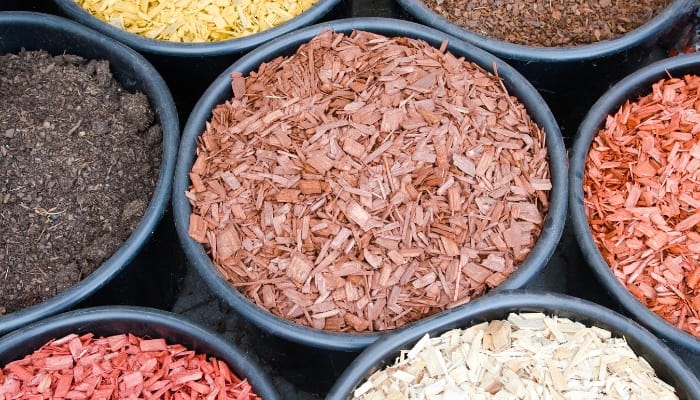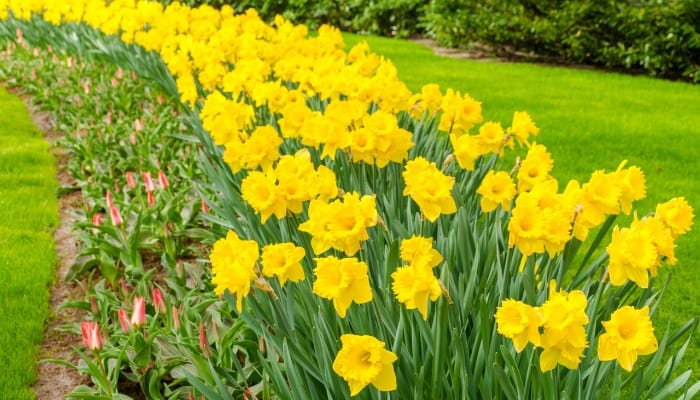When growing daffodils, adding mulch to a garden can effectively minimize the presence of weeds, retain moisture, and enrich the soil with organic materials.
Sometimes it can be difficult to remember where your daffodils are growing once you’ve cut them back for the season, but mulch and daffodils are great when used together.
Daffodils will grow through a layer of mulch that is up to 3 inches thick. Mulching over your daffodil bulbs won’t inhibit their growth and will help prevent weeds from growing over them, inhibiting sprouting. Daffodils grow from stored energy in their bulbs and can push through the mulch with ease.
In addition to the beauty that mulch adds to your garden, it is great for other purposes as well.
Continue reading to learn why mulching will help your daffodils, how to use mulch effectively around them, and how to do it right!
Mulching Daffodils – What To Know
Whether your daffodils are still green with leaves and flowers or cut back for the season, mulch is a great material that will help them grow. Here are some clarifications on how and why to mulch daffodils.
Should Daffodils Be Mulched?
Daffodils should be mulched because it will help keep the bulbs moist and weeds from invading their shoots. In cooler climates, it will help to keep the bulbs warmer in cold spells, reducing the chance of frost affecting them negatively.
Will Bulbs Grow Through Mulch?
Daffodil bulbs grow from a few inches below the soil and have plentiful stored energy within them to grow new shoots in the spring.
These shoots are strong enough to push through thick, dense, and solid soils, so growing through mulch is easy for them!
Benefits of Applying Mulch in Daffodil Bed
Applying mulch in your daffodil bed will prevent weeds from growing over your daffodil bulbs, making it difficult for them to sprout.
Mulch will also promote healthy growth as the mulch breaks down and adds organic material to the soil, feeding the flowers. It is also great at regulating soil temperature and moisture from hot, dry spells and cold, wet spells.
When To Apply Mulch
It is best to apply mulch in early spring when your garden is beginning to flourish for the season and can benefit from a good cleanup.
Wood mulch usually doesn’t fare well over the winter and breaks apart, but grass and leaf mulch are great to add at the end of the season to feed your garden before snow covers the ground.
Mulch Depth
Mulch should be applied in a 2-inch thick layer to ensure it does its job of retaining moisture, preventing weeds, and helping to regulate temperature.
Applying mulch too thickly can create anoxic soil conditions and allow fungus and mold to thrive.
Best Types of Mulch for Flower Beds

Depending on your goal of adding mulch, it is best to choose a type that can add beauty to your garden while adding nutrients.
Sometimes an artificial mulch is best in high-traffic areas or when you are hoping to achieve a long-lasting look.
Wood Mulches
Mulches made of shredded wood can be great for mulch because they break down and supply natural nutrients to the soil. They are available in an array of colors and sizes. The smaller sizes will be easier for bulbs to poke through.
Shredded Leaves & Grass Clippings
If you’re looking for a place to put all of your yard clippings after mowing the yard or cleaning up for the fall, place them in your garden! They will decompose and supply a great number of nutrients to your plants as it decays.
If you prefer the look of wood mulch, you can still apply a layer of leaves or grass underneath a mulch layer to still feed your plants!
Rubber Mulches
Rubber mulches are great at keeping their color and shape longer since they don’t decay. Unfortunately, they don’t supply any nutrients to your garden, but you can always place the rubber mulch on top of your yard clippings to still receive the benefits of both materials.
Pine Straw
Pine straw mulch is great because it is lightweight and breaks down really slowly, and if you have pine trees, it can be free!
Otherwise, bales of pine needles are usually relatively inexpensive and much lighter to work with compared to other mulches. If you use pine needles season after season, it may begin to affect the soil acidity, but not by much.
Wheat Straw or Hay
It is always best to use wheat stray over hay because hay contains bountiful seeds that will germinate in your garden, creating a serious weed problem!
Even straw can contain seeds at times, but it is usually a cleaner option. It will break down slowly, keeping your garden beds covered for a season or two.
Guide To Applying Mulch
While mulching your garden sounds as easy as riding your bike, there are some key steps to make sure your mulch correctly and don’t negatively impact your plants.
Best Practices
Buy mulch from a reliable source. Many times mulch can be treated with dyes or pesticides that do more harm than good, and straw mulches can be filled with seeds.
Spread the mulch evenly, and always remove weeds before mulching to help eliminate them from the garden. In some cases, adding landscaping fabric under your mulch will help get rid of weeds in heavily infested areas.
Mulch seasonally to keep your garden free of weeds, add organic material to your soil, and help your plant thrive.
What NOT To Do
Applying mulch is easy, but there are some precautions to take into consideration for the best results!
Applying mulch too thickly can cause mold and fungus to grow, overtaking your garden and making your yard unsightly!
Don’t apply mulch too close to the base of your trees and shrubs. Leave 3-6 inches around the trunk lightly mulched or exposed to allow for proper ventilation of the roots and trunk.
Related Questions:
Will Bulbs Grow Through Landscape Fabric?
Bulbs will not be able to grow through landscape fabric because it will prevent the leaves from ever reaching sunlight.
To use landscape fabric with bulbs, cut out circles in the fabric where the bulbs are. Then they will grow through without any trouble!
Will Daffodils Grow in Shade?
Daffodils will not grow in the shade but will tolerate partial shade. They require a minimum of 6 hours of sunlight and will benefit from more.
Closer to 8+ hours will have them thriving with the most beautiful blooms. There are a few shade-tolerant varieties like the Triandus and Cyclamineus varieties if sunlight in your yard is limited.
Conclusion
Mulch can do so much more than add a lovely backdrop to your garden!
By adding nutrients, preventing weeds, and reducing temperature and moisture fluctuations in the soil mulch will allow your daffodils to thrive and grow with ease!

